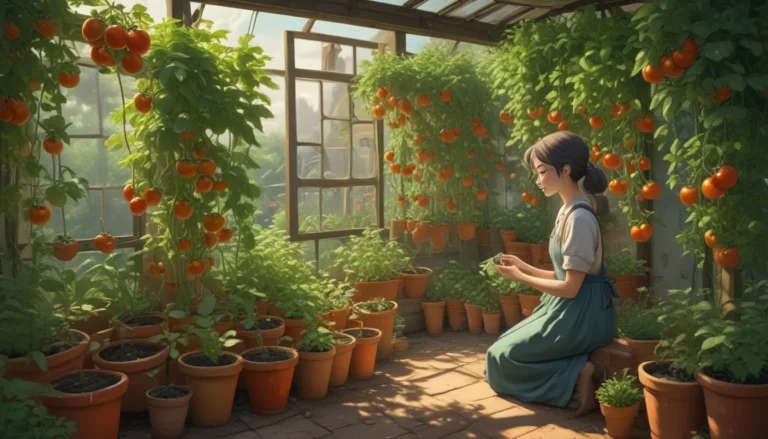A Comprehensive Guide to Growing Rembrandt Tulips

Are you captivated by the allure and beauty of Rembrandt tulips? These stunning flowers have a rich history and a striking appearance that make them a favorite among gardeners. In this in-depth guide, we will delve into the cultivation, propagation, and care of Rembrandt tulips. Whether you are a seasoned gardener looking to expand your knowledge or a novice eager to learn more about these exquisite blooms, this guide will equip you with all the information you need to grow and enjoy Rembrandt tulips in your garden.
Cultivation and History
Rembrandt tulips belong to the Triumph group of tulips, Division 9, known for their single blossoms and strong stems. Named after the Dutch painter Rembrandt Harmenszoon van Rijn, these tulips were not originally associated with the renowned artist. However, a painting titled “Saskia as Flora” features a red and white tulip in the floral crown of his wife, Saskia van Uylenburgh, inspiring the name “Rembrandt.”
The history of Rembrandt tulips is intertwined with the infamous “tulipmania” that swept through Holland in the 17th century. During this period, tulips became a symbol of wealth and status, with collectors paying exorbitant prices for unique and colorful specimens. The mesmerizing variations in tulip colors were attributed to the mosaic virus, also known as the tulip breaking virus.
While the original Rembrandt tulips were prized for their unique coloring, they were eventually found to be weak and susceptible to disease. Modern hybrids have been bred to mimic the appearance of the virus-infected tulips without the fragility and unpredictability associated with the disease. Today, most Rembrandt tulips available are improved hybrids that showcase the vibrant colors without the risk of disease.
Propagation
When propagating Rembrandt tulips, it is essential to provide well-draining soil to prevent waterlogging. Bulbs can be planted in the fall, with a spacing of six inches and a planting depth of three inches. Alternatively, bulbs can be divided from existing clumps after the leaves have died back in the summer and replanted for propagation.
How to Grow Rembrandt Tulips
To ensure healthy growth of Rembrandt tulips, it is important to monitor watering practices. Tulips prefer moist soil during the fall, winter, and spring but should be allowed to dry out in the summer when they are dormant. Summer watering can shorten the lifespan of the plants, so it is advisable to reduce watering during this period.
For gardeners in Zone 8 and above, storing bulbs in the refrigerator for eight weeks in the fall can help simulate the winter chill required for growth. Fertilizing with a balanced NPK fertilizer in the summer after blooming can promote healthy growth and vibrant flowers. Additionally, storing bulbs in a cool, dark location during the summer and replanting in the fall can extend the lifespan of Rembrandt tulips.
Growing Tips
- Reduce watering in the summer.
- Fertilize in the summer after blooming.
- Replace faded plants after a few years.
Maintenance
Proper maintenance of Rembrandt tulips involves allowing the leaves to turn completely yellow and brown before cutting them. Removing dead leaves should be done gently, ensuring they come away from the plant easily. This practice can promote the return of healthy blossoms year after year.
Cultivars to Select
Selecting the right cultivars of Rembrandt tulips can enhance the beauty of your garden. Among the recommended cultivars are:
Carnaval de Rio
Featuring bright red flames on a white base, these rose-type single flowers offer vibrant colors without the risk of virus infection.
Grand Perfection
Modern Rembrandt perfection, with creamy yellow petals and maroon stripes on a white base, this cultivar creates a masterpiece in your garden.
Helmar
With bold flame-like stripes, ‘Helmar’ stands out with its intense color and tall stature, making it a striking addition to any garden.
Insulinde
A Bijbloemens type with swirls of reddish-purple, ‘Insulinde’ offers a classic look reminiscent of the original Rembrandt tulips.
Mickey Mouse
Featuring classic bizarre coloring in bright yellow and flaming red, ‘Mickey Mouse’ adds a playful touch to the garden with its early flowering.
Rem’s Favorite
With darker purple flaming stripes, ‘Rem’s Favorite’ exudes elegance and charm, reminiscent of the tulips of the Dutch masters.
Managing Pests and Disease
Rembrandt tulips are susceptible to herbivores such as deer, rabbits, and voles, which can damage bulbs and leaves. Additionally, they are prone to common pests and diseases that affect tulips. Implementing strategies to deter herbivores and prevent pest infestations can promote the health and vitality of your Rembrandt tulips.
Best Uses
Rembrandt tulips are versatile plants that thrive in borders, mass plantings, and containers. Pairing them with complementary plants such as crocuses, daylilies, and ornamental alliums can create a visually stunning display in your garden. Additionally, Rembrandt tulips are ideal for cut flower arrangements, adding a touch of elegance to any bouquet.
Quick Reference Growing Guide
- Plant Type: Perennial flowering bulb
- Flower / Foliage Color: Brown, pink, red, white, yellow/green
- Native to: Modern Kazakhstan and other parts of Central Asia
- Water Needs: Moderate
- Hardiness (USDA Zone): 3-10
- Maintenance: Low
- Bloom Time / Season: Spring
- Tolerance: Summer drought
- Time to Maturity: Up to 3 years (bulblets)
- Soil Type: Loamy, loose
- Exposure: Full to part sun
- Soil pH: 6.0-6.5
- Spacing: 6 inches
- Soil Drainage: Well-draining
- Planting Depth: 3 inches
- Companion Planting: Crocuses, daylilies, lilies, grasses, ornamental alliums, snapdragons
- Height: Up to 2 feet
- Spread: 6 inches
- Growth Rate: Fast
- Common Pests and Diseases: Aphids, bulb mites, deer, rabbits, slugs, snails, spider mites, voles, wireworms; basal rot, botrytis blight, tulip breaking virus, tulip crown rot
Conclusion
In conclusion, Rembrandt tulips are a fascinating and captivating addition to any garden, with their rich history and vibrant colors. By following the cultivation, propagation, and care tips outlined in this guide, you can grow and enjoy these beautiful flowers in your own backyard. Whether you opt for modern hybrids or heirloom cultivars, Rembrandt tulips are sure to add drama and elegance to your garden landscape. So, why not embark on the journey of growing these exquisite bulbs and witness the beauty they bring to your outdoor space?
Feel free to share your plans for growing Rembrandt tulips in the comments below. We would love to hear about your gardening adventures and the cultivars you are excited to cultivate. Happy gardening!





